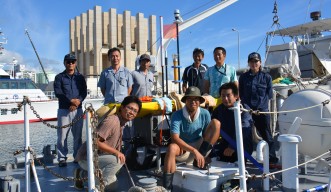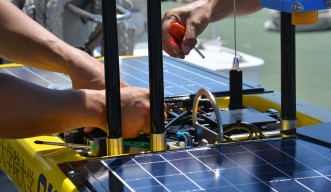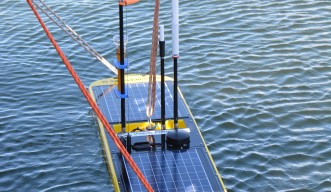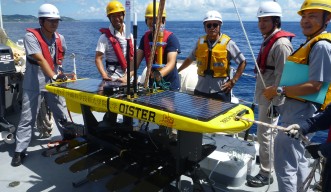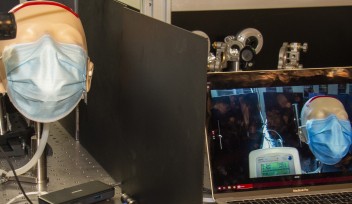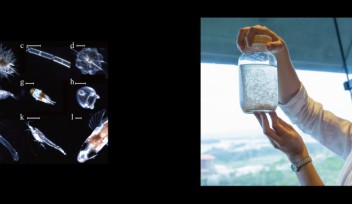OISTER Goes Out to Sea
The Wave Glider is a next-generation oceanographic observation robot that institutions from around the world want to employ; the Wave Glider requires no fuel for navigation since it adjusts its movement accordingly with the waves, and the various instruments loaded onto it are powered solely by solar energy collected by panels attached to the Glider. Thanks to a collaborative effort between OIST’s Marine Biophysics Unit and the 11th Regional Coast Guard Headquarters (11th HQ), the Wave Glider, nicknamed “OISTer,” was launched into the sea from the 11th HQ’s survey ship, “Okishio” on August 7. This innovative robot now glides through the oceans of Okinawa making observations that benefit researchers and rescue teams alike. It will monitor the area between Okinawa and the Daito Islands. The Glider navigates by following commands transmitted from OIST via satellite.
What makes the Wave Glider so attractive is its potential to take measurements that were not possible before. “The main objective for this launch is to observe ocean parameters inside typhoons in real time,” says Professor Satoshi Mitarai, who leads the OIST Marine Biophysics Unit. Although typhoons hit Okinawa year after another, detailed observations of parameters such as water temperature, salinity, and current flow have not been made because of methodological constraints. Satellite images were a major data source, but were limited since image resolution blurred in cloudy weather. Another shortcoming of methods up to date was that it was not possible to track changes in parameters as the typhoon developed. In contrast, the Wave Glider provides an excellent opportunity to collect real-time data while following the typhoon as it grows.
Being able to collect field data on typhoons will be a great asset to future rescue operations and accident prevention. The 11th HQ is currently undertaking a project to prioritize search areas in case of marine accidents, for instance predicting where shipwreck victims may have drifted, or how spilled fuel from a capsized ship might spread. Field data from the Wave Glider will substantially improve prediction accuracy. Moreover, data from Wave Glider will help to improve the sophistication of high-resolution simulations of the Kuroshio Current and Okinawan tidal flows that the Marine Biophysics Unit is developing.
The Wave Glider is already in use in the US, monitoring the spread of oil in the Gulf of Mexico. In Japan, this is the first time that the Wave Glider has been launched for a long-term operation. There are also plans to use data from this innovative robot for a project in other OIST labs. The OIST Fluid Mechanics Unit and the Continuum Physics Unit are planning a project to monitor the friction between the ocean surface and the wind during typhoons. For projects like these, it is necessary to approach the typhoon closely, which the Wave Glider can do. The wide range of possible applications of this versatile device offers marine researchers many exciting new options.
Specialty
Research Unit
For press enquiries:
Press Inquiry Form










